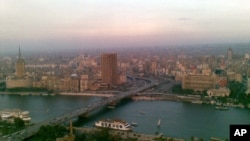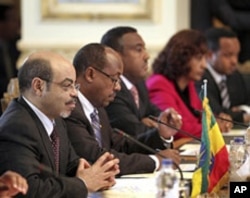In the beginning, Egypt was the Nile. That could now change, as Egypt, Sudan and the countries that supply the Nile’s waters face new politics, economic development, skyrocketing demographics and climate change. Egypt confronts at least a half a dozen other African countries that have for generations delivered their waters to Egypt’s Nile. What historically appeared to be Egypt’s birthright has now become a privilege they must negotiate with their upstream neighbors. It is a major issue in Egypt’s upcoming elections.
“Some of the political parties are talking about the Nile agreement,” said Dr. Mahmoud Abu-Zeid, “but all of them are talking about water security, which means no disturbance of the historic rights and that countries should not implement projects which would affect our uses of the Nile in Egypt.” And that is what is at stake for Egypt as a newly elected government in Cairo will define its role in a new regional initiative that will decide the future of the Nile and its beneficiaries.
The Nile Basin Initiative was begun in 1999. Dr. Abu-Zeid spent a good part of his 12 years as Egypt’s minister of water resources and irrigation trying to save those historic water rights in negotiated agreements with Ethiopia and at least five other African countries. A few months ago, it became clear that upstream neighbors could replace Egypt’s old river-related traditions, with or without Egypt and Sudan. Then, Ethiopia announced construction of a new dam that made Cairo nervous.They call it the Renaissance Dam.
“We saw that the new dam Ethiopia has started to build might affect the historic rights of Egypt,” said Abu-Zeid. Construction of Ethiopia’s $5 billion hydro-electric dam on a principal source of Egypt’s Nile began several months ago.
Ethiopia recently agreed to host officials from Egypt and Sudan to prove that the dam, now called the Renaissance Dam, will not be used to irrigate any of the large corporate farms the Ethiopian government has leased to foreign investors in recent years. Though Ethiopia’s funding of the dam’s construction is uncertain, Egypt remains concerned and suspicious.
“What we have been assured is that this dam is for hydro-electric and that it has no irrigation schemes in it,” said Abu-Zeid. “On the other hand, we have heard about irrigation schemes in Ethiopia and we’re not sure if any of them are in the Nile Basin.”
Mathematics of the Nile
Population has driven much of the new politics in the Nile Basin. “Water doesn’t increase, but the population does,” said Richard Tutwiler, a research professor at the American University in Cairo and director of school’s Desert Development Center. In the 1950s, when Egypt and Sudan decided how much of the Nile they needed, there were about 22 million Egyptians and 9 million Sudanese and 18 million Ethiopians.
Today, Egypt has a population of 82 million, Sudan has a population of 45 million, and Ethiopia has a population of 85 million. Between these three countries the population has increased four times and in recent years Egypt has succeeded in increasing by 25 percent its inventory of farmlands by irrigating deserts through extensive and expensive canal systems.
The other important numbers facing Egypt and its upstream neighbors are the average annual flows into Lake Nasser. The total is 85 billion cubic meters per year. Egypt uses approximately 55.5 billion cubic meters, and some say that in years of high rainfall, Egypt has used more than their share. Sudan (prior to South Sudan's independence) typically used 18.5 billion cubic meters. The remaining 10 billion evaporates on the way to or in Lake Nasser. The basin members upstream have already taken their share before it reaches Lake Nasser but population, economic development and climate change are affecting all members of the basin.
Ethiopia takes high ground
Ethiopia’s ability to determine any of these events is a new achievement after years of being ignored by Egypt’s and Sudan’s Nile-based development.
In 1959, Egypt and Sudan met and agreed on how to share the waters of the Nile as it flowed through their largely arid lands on the way to the Mediterranean. It was a renewal of river rights they had enjoyed since the British signed an agreement with the two countries in 1929. Ethiopia, which provides an estimated 85 percent of the flow into Lake Nasser from the Abay and other watersheds to the south, was not invited. Emperor Haile Selassie wrote a letter of protest, to no avail.
After the 1979 Camp David agreement returning the Sinai Peninsula to Egypt, President Anwar Sadat announced the launch of the Salaam Canal which would divert Nile waters to the Peninsula by siphoning the waters beneath the Suez Canal. Colonel Mengistu Haile Mariam, then the ruler of Ethiopia, protested to the United Nations, to no avail.
“There was a lot of antagonism between these two countries, Egypt and Ethiopia, and this has been going on since Sadat,” said Steven McCaffrey, a law professor at Pacific University in Sacramento. McCaffrey served for three years as a legal advisor on the creation of a cooperative agreement for three years and advised the Nile Basin council of ministers for one year.
Egypt played a major role in the decade of Nile talks that were sponsored by the World Bank and other donors. The nine basin members discussed and drafted a Nile Basin Initiative to manage the entire resources of the Nile with greater equity and efficiency. If these efforts succeed, the new agreement could end - or at least minimize - decades of enmity.
But upstream neighbors have so far not agreed to Egypt’s demand that no upstream nation can use water that would reduce their annual 55.5 billion cubic meters or to permit Egypt to maintain the right to veto or even have prior review of upstream proposals.
Balancing powers on the Nile
An observer of these Nile negotiations said, ”Fifty years later, the stakes are very high. Ethiopia felt this is now their time in the sun. And they were seen by Egypt as a threat.”
The party in power for the past 20 years in Ethiopia is the Ethiopian People’s Revolutionary Democratic Party, headed for almost all of that time by Prime Minister Meles Zenawi. They struggled to find an economic policy to, as some in the party’s leader like to say, bring Ethiopia “out of backwardness and poverty.”
“They promised a lot of development but were faced with drought and degraded watersheds,” said the observer of the negotiations. Ethiopia became more determined to push massive development of roads, bridges and dams with the considerable assistance of Chinese loans and expertise. With a series of new hydro-electric dams coming online, Ethiopia wants to become this corner of Africa’s hydro-electric power center.
Some, who have watched the Nile’s political changes, believe that Meles altered the contentious tone of Egypt-Ethiopia relations a few months ago by telling a delegation from Cairo’s transitional government that ratification of the agreement by the upstream signers can wait until Egypt, coming out of a revolution and regime change, could study the proposals and inspect the Renaissance Dam plans.
“I think that was a very statesman-like position that Meles took,” said Tutwiler, director of the Desert Development Center in Cairo.
The former Egyptian negotiator, Abu-Zeid, is now president of the Arab Water Council in Cairo. He remains confident that Egypt will not be harmed by plans that will have to be approved by a consensus or a simple majority of the Nile Basin partners.
“There is enough water for everybody,” said Abu-Zeid. “The Nile is so big that everybody can get his share. We should not worry about the availability of resources. We should worry about how to develop joint programs for the benefit of everybody.”
If Egypt and Sudan join the Nile water partnership, the decisions the basin makes will be difficult, and will require new relationships among those who feed Lake Nasser and those who take from it.
1 Oct - cost of the Renaissance Dam corrected from $5 million to $5 billion







